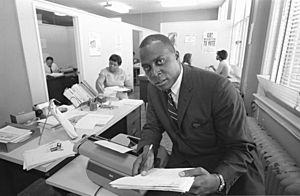Voter Education Project facts for kids
The Voter Education Project (VEP) was an important group that helped people, especially Black Americans, register to vote in the southern United States. From 1962 to 1992, the VEP collected and shared money from foundations with civil rights organizations. These groups used the funds to teach people about voting and help them sign up. The Kennedy administration supported the VEP. They hoped that civil rights groups would focus more on voter registration and less on big public protests.
| Top - 0-9 A B C D E F G H I J K L M N O P Q R S T U V W X Y Z |
Why the VEP Started
In the early 1960s, many students began to protest for civil rights. They held sit-ins at segregated lunch counters and went on Freedom Rides to challenge unfair laws. These actions, while brave, caused problems for the Kennedy administration. News stories, photos, and TV images showed racist violence and police stopping peaceful protests.
At this time, many countries in Asia and Africa were becoming independent from old colonial rule. The U.S. and the Soviet Union were in a Cold War, trying to get these new nations to be their friends. The news about racial problems in America made it harder for the U.S. to convince these countries to support them.
How the VEP Was Formed
President John F. Kennedy and his brother, Attorney General Robert F. Kennedy, believed that the student protests were causing the negative news. They asked civil rights leaders to focus on voter registration instead of protests.
The Kennedy brothers quietly convinced several non-profit foundations to give money for voter registration work in the South. Foundations like Taconic, Field, New World, and Stern Family agreed to help. To manage and give out this money, several important civil rights groups came together. These included the NAACP, the Congress of Racial Equality, the Southern Christian Leadership Conference (SCLC), and the Student Nonviolent Coordinating Committee. They formed the Voter Education Project (VEP) under the Southern Regional Council, which was a non-profit organization.
VEP Activities and Successes

The VEP quickly got to work. For example, after the Albany Movement, the VEP helped almost 500 people register to vote in Albany, Georgia, in just two weeks.
In its early days, the VEP faced some challenges. By the end of 1964, however, the VEP had given out nearly $900,000 to civil rights groups. This money helped almost 800,000 new Black Southern voters sign up. After the Voting Rights Act was passed in 1965, VEP-funded efforts helped another 175,000 Black voters register.
The VEP continued to fund voter registration, education, and research in the South until 1992. Important leaders like Randolph Blackwell, Vernon Jordan, John Lewis, and Ed Brown served as directors of the project.
Impact of the VEP
The VEP made a big difference in helping people register to vote, especially in rural areas. However, the Kennedy administration had hoped the VEP would reduce the violence against civil rights efforts. This did not happen.
In the Deep South, many white people strongly resisted Black Americans gaining the right to vote. This resistance was often more violent than their opposition to integrating places like lunch counters. Instead of decreasing, news stories showed more police actions, violence, bombings, and even murders. White political leaders, groups like the Ku Klux Klan, and White Citizen Councils used arrests, fear, and economic threats to stop Black people from voting.
See also
- New York Foundation
- "Mapping the VEP" - a digital public history map showing VEP-supported registration campaigns across the American South from 1962 to 1970 - http://www.mappingthevep.evanfaulkenbury.com/

